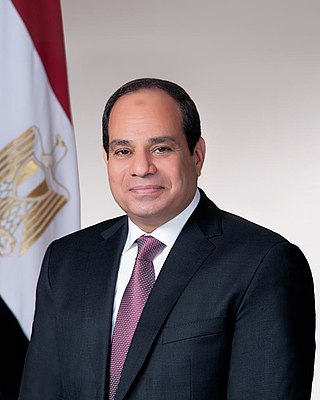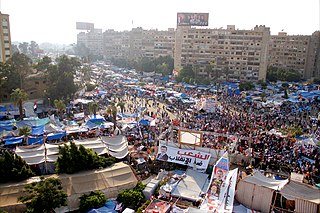Timeline
The start of the protests
On August 29, after Sisi had issued a referendum asking people if they wanted him to remain president or not, a Twitter campaign was launched issuing discontent about Sisi's administration with the hashtag "we don't want you" (Arabic: #مِش_عايْزينَك, ALA-LC: mishʿāyzīnak). [7] During this campaign the first calls for a revolution on September 20, being the anniversary of the preceding year's protests, were published online and gained much attention. [7] After Muhamed Ali supported the campaign by posting a call to action himself, people turned to the streets on September 20. [3] The protests were not led by any known opposition movements. [5]
Different from the 2019 protests was that some people believed that there would be no response to Ali's calls because people were afraid of getting arrested. [15] [7] Others believed that Ali deliberately wanted people to get detained or killed in protests, even going so far as accusing him of working together with the government. [15] Despite these thoughts, protests started on September 20 and several photos and videos of alleged demonstrations in 17 Egyptian governorates started circulating the internet. [15] The videos and photos were accompanied by hashtags that became trending on Twitter, e.g. "the revolution began", "down with military rule", [15] and "go out on 20 September" (Arabic: #اِنْزِلـ20ـسِبْتِمْبِر, ALA-LC: #inzil_20_sibtimbir). [16]
The course of the protests
The protests started in Giza, Cairo, Suez, Kafrl El Dawwar, Alexandria, Aswan, and El Qanater El Khayreya [4] and mostly took place in rural areas in Egypt and Upper Egypt. [17] Because of that, they are also referred to as Galabiya Uprising. [17] In Aswan, a presidential residence was set on fire after security forces attacked protesters. [4] People furthermore threw stones at police vehicles. [4] In El-Qanatar, protestors walked through small streets to try to not get attacked by security forces. [4] In the village of Al-Kadaya (also written as Kidaya), Atfih, people had overturned a police car and set it on fire after security forces had surrounded them and asked them not to protest. [1]
On September 22, demonstrations continued in Giza, Fayoum, Minya, Luxor, and Aswan. [1] Protesters pushed a car in a canal in Al-Hawarta, Minya, after security forces used teargas and fired weapons at them. [18] In several places cafes took precautions by closing their doors to protect their business, [4] in some cases they were forced to do so by authorities. [19]
Friday of Rage

Protests continued on September 25, marking the sixth day of anti-Sisi demonstrations. [5] People had increasingly called for protests to be taking place on Friday September 25th in the days before. [20] Thousands of people responded to these calls by demonstrating after Friday prayer in Cairo, Giza, Damietta, and Luxor. [5] This day is also referred to as "Friday of Rage", [5] or "Friday of Anger". [20]
Several video's were distributed through Twitter on which people are heard chanting "say it out loud and don't be scared, el-Sisi has got to go". [5] Protesters furthermore burned tires as a roadblock. [5] The police and security forces responded by charging their weapons at the crowd, trying to disperse the protesters. [5] In a shooting in al-Blida, in the Giza governorate, three people got wounded, and one 25 year old man, Sami Wagdy Bashir, was killed when riot police tried to disperse the crowd. [5] [17] It is unclear how many people were arrested after the protests on Friday the 25th; the total number of arrest since the start of the protests was estimated to be around 400. [17]
Using Friday as a day of protest and mobilization has been done in other mass protests in Egypt since the January 25 Revolution. [21] This is often paired with a symbolic name, such as "Friday of Unity", "the Friday of the Last Chance", "Friday of Anger" on 28 January 2011, and "Friday of Rage" on 25 September 2020. [21] [5] Protesting on Friday as a focal day occurs in other countries in the MENA region as well. [21]
September 30th
On September 30, Awais Al-Rawi was shot and killed by police, according to eyewitnesses. [22] [23] [24] Police raided Al-Rawi's family home in an attempt to arrest a family member who had participated in protests the week before. [24] They instead arrested Al-Rawi's younger brother to which their father objected, to which a police officer reacted by slapping Al-Rawi's father. [24] Al-Rawi objected verbally about the treatment of his father and the argument escalated, resulting in an officer shooting him. [24] During the funeral on the same day, mourners chanted "Sisi is the enemy of God" and "retribution by bullets", to which the police responded by firing warning shots and teargas, and arresting several people. [24] A video of the funeral was posted on Twitter. [22] [24] In a response to the police's reaction, civilians kidnapped and beat an officer who was released after negotiations between tribal elders and a police official. [24] The officer who killed Al-Rawi was suspended and would be interrogated. [24]
Government responses
The government started taking preemptive methods since September 10th when rumors of demonstrations spread. [19] [23] These preemptive methods included random searches of residents and pedestrians, [25] police checking peoples phones, [10] and arresting over 1000 activists, political figures, intellectuals, university students, and other citizens. [3]
When the protests occurred, security forces were deployed and military checkpoints were set up in several cities. [4] [14] Security was especially cautious on Fridays. [14] in several places where protests took place, security responded to protesters with more violent measures by using birdshot (khartoush), teargas, and live bullets against protesters. [23]
Authorities and state-run media furthermore responded to the protests by denying they were taking place. [1] Several media channels said the videos and photos circulating the internet were Muslim Brotherhood propaganda, stating that there were no actual demonstrations taking place. [2] The intelligence affiliated United Media Services Group, which is owned by one of the Egyptian intelligence agencies (Mukhabarat, military intelligence, National Security Agency) and owns Youm7, filmed a fake protest and distributed it to satellite channels associated with the Muslim Brotherhood to show as evidence of the Brotherhood's fabrication of demonstrations. [2] As videos and photos of demonstrations kept circulating the internet, instead of denying the demonstrations from taking place, state-led media said they were staged and that the footage shown was Muslim Brotherhood violence. [2] Some pro-government people, channels, or news outlets responded by stating the demonstrations were small in size. [1] [10] On September 25, when Friday of Rage was taking place, several pro-government news media continued stating there were not any protests taking place. [5]
International responses
The international responses to the 2020 Egyptian protests were limited. On September 20, Amnesty International issued for detained protesters of the 2019 protests to be released. [1] Then on September 22, the UN stated that people should "be allowed to express themselves, and for governments to listen to the people." [1]














